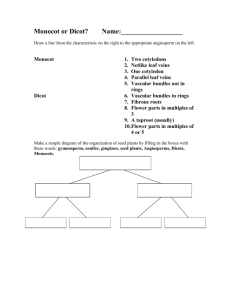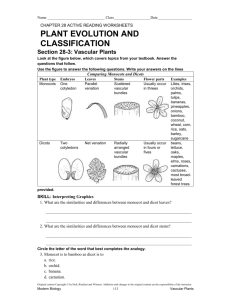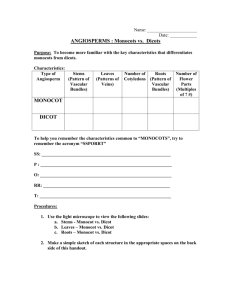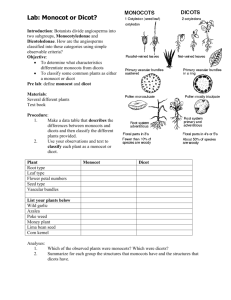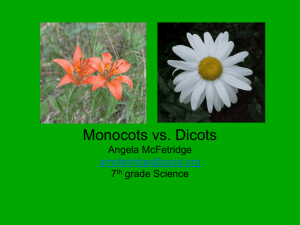Year 10 Biology term 1
advertisement
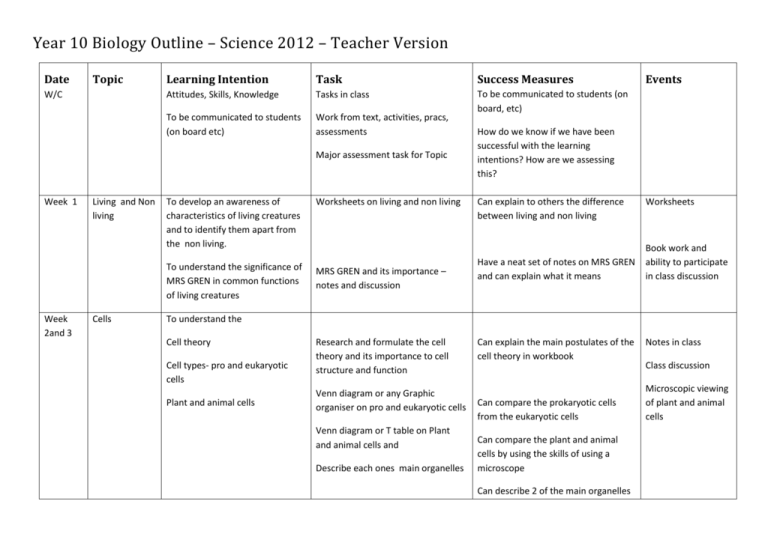
Year 10 Biology Outline – Science 2012 – Teacher Version Date Topic W/C Learning Intention Task Success Measures Attitudes, Skills, Knowledge Tasks in class To be communicated to students (on board etc) Work from text, activities, pracs, assessments To be communicated to students (on board, etc) Major assessment task for Topic Week 1 Week 2and 3 Living and Non living Cells To develop an awareness of characteristics of living creatures and to identify them apart from the non living. Worksheets on living and non living To understand the significance of MRS GREN in common functions of living creatures MRS GREN and its importance – notes and discussion Events How do we know if we have been successful with the learning intentions? How are we assessing this? Can explain to others the difference between living and non living Have a neat set of notes on MRS GREN and can explain what it means Worksheets Book work and ability to participate in class discussion To understand the Cell theory Cell types- pro and eukaryotic cells Plant and animal cells Research and formulate the cell theory and its importance to cell structure and function Venn diagram or any Graphic organiser on pro and eukaryotic cells Venn diagram or T table on Plant and animal cells and Describe each ones main organelles Can explain the main postulates of the cell theory in workbook Can compare the prokaryotic cells from the eukaryotic cells Can compare the plant and animal cells by using the skills of using a microscope Can describe 2 of the main organelles Notes in class Class discussion Microscopic viewing of plant and animal cells of each plant and animal Week 4 Cell Organelles To identify the structures and functions of Cell parts identification Cell organanelles: Plasma membrane, Cell wall, Mitochondria, ER, Golgi bodies, RIbosomes, Vaccuoles, Cytoplasm. Week 4 Week 5 Week 6 Cell Organelles To create a cell analogy and to present their findings to the class Plants To identify plants Parts of plants To identify structures and functions of plant parts Plant types Monocot and Dicot plants Salient features to identify them Examples of Monocot and Dicot Ability to identify cell parts or organelle diagrammatically Cell organelles table completion Ability to research functions of any 5 cell organelles Ability to identify cell parts with a chosen analogy or comparison to a system or structure such as a village Cell analogy worksheet How are plants different from animals- research and articulate Can identify what makes a living creature a plant To identify main parts of a plant Can tell the main parts of plants under vegetative and reproductive structures Can come up with a table or poster to say what are the parts of plants. Cell analogy or comparison activity Creating a table of main features of monocot and dicot plants Can explain the terms monocot and dicot plants Providing examples of each type Can demonstrate 2 differences between monocot and dicot Creating a cell analogy and presentation Can explain the functions of these parts Diagrams and/or Poster on difference between monocot and dicot plants Can classify a specimen as mono or dicot Week 7 Revision Plants revision Study skills and Revision Research and revision Revision test Week 8 Revision and Exam Revision Revision Revision Exam
